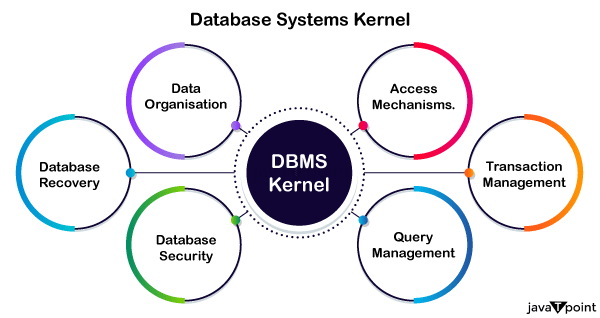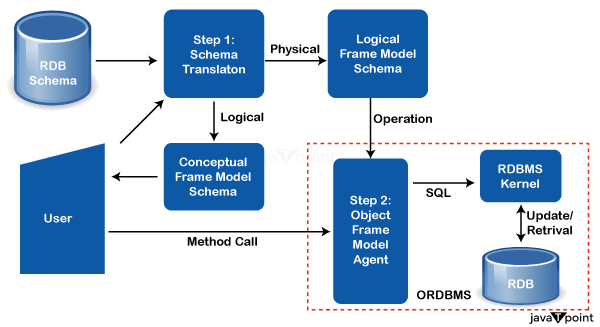What is RDBMS Kernel?
RDBMS Kernel:

The RDBMS Kernel is the main building block of Relational Database Management System and is very important and fundamental in managing the data, command execution, and ensuring data integrity and concurrent control.
Knowing how the database kernels function in RDBMS is crucial for covering the needs of developers and administrators in achieving top database performance and reliability.
A robust RDBMS Kernel can facilitate all these as its absence will be a serious issue since the volume of information to be handled will be enormous. With Kernel RDBMS looking after this data, it not only organizes and easier interactions between users, applications, and the storage layer internally, but also ensures that business operations run efficiently and smoothly allowing the employees to focus on the main business activities.

Functionalities of an RDBMS Kernel:
Data Storage:
- Transforming data from its 'natural form' or spread over different fields into one single entity.
- Keeping track of tape and disc usage and data movement to and from these storage devices.
Data Retrieval and Manipulation:
- Performing SQL's data queries for the purposes of retrieve, insert, update and delete data.
- Enforcing data entities constraints. The international trade has been aided through several conventions like agreements on specific tariff concessions, preferential trade agreements, and trade-related agreements on intellectual property rights.
Transaction Management:
- Keeping the ACID properties of transactions simultaneously (Atomicity, Consistency, Isolation and Durability).
- Managing parallelized transactional operations and their exception management mechanisms.
Concurrency Control:
- Preventing of data inconsistency through transactions where concurrent process share resources.
- By locking and isolation levels implementation, data Figure is kept consistent.
Indexing and Optimization:
- Operating indexing in order to improve data nailing.
- Converting query execution plans for a better performance by using the method like query rewriting and cost-based optimization.
Security and Access Control:
- Authentication needs to be in place and access to be controlled for all the database's objects.
- Exhibiting security measures like RBAC and encryption among others.
- Write a paper in which you discuss the potential impacts of automation on jobs.
- Begin by providing an overview of the current state of automation technology in society. Discuss the advancements in fields such as artificial intelligence, machine learning, data analytics, and robotics. Explain the types of tasks and roles that these technologies could potentially automate or augment in the
Backup and Recovery:
- Backup of data to abate against failures and persistent data payment.
- Help users in system failures and data loss recovery processes by providing data recovery processes.
Components of an RDBMS Kernel:
Query Parser:
Implement enable SQL statement parsing and query execution plan generation so that applications can be used by layers and data miner.
Query Optimizer:
Compares the obtained query results and optimizes the execution plans for higher speed and performance.
Transaction Manager:
Coordinates operations in a transactional way andCoordinators: Transactional operations and / or ACID properties should be guaranteed.
Concurrency Control Manager:
Keeps track of simultaneous usage of shared resources, and eliminates logical conflicts arising between the users.
Indexing Engine:
Develops and maintains indexes to quicken the forming of search queries.
Storage Manager:
Data management, including disk allocation system, and data placement.
Security Module:
Incorporates surveillance of data and requests as well as utilizes authentication, authorization, and encryption schemes.
Backup and Recovery Module:
Manages backups to save data, restores it, and recovers it.
Logging and Recovery Module:
Record the changes in transactional logs files and help in the process of database recovery by its means.
Error Handling Module:
It catches program errors and exceptions, working as a foundation for solidity and dependability.
Importance:
An element of the importance of an RDBMS kernel is that it lies in being the very centre of an activity of relational database management. Here are some key aspects highlighting its significance:
- Data Management: The RDBMS kernel is a toolkit which provides a rigid design pattern for organizing the data in the form of relationships. This is done on tables which are arranged with rows and columns in such a way, it ensures very little storage space, easier retrieval and manipulation of the data.
- Data Integrity: Secure data storage builds the core of the database. The core acts as a data integrity enforcement mechanism by using the correct data types like primary keys, foreign keys and more.
- Data Security: Security is the most salient issue of databases, and the matter is particularly delicate when personal data must be protected. Whereas the kernel implements authentication, authorization, and encryption mechanisms to screen out data and provide compliance with security norms and laws.
- Scalability: The RDBMS kernel which is part of the database kernel plays an important part in improving the performance of the database system scale. Its capability to control data storage, retrieval, and processing, makes it more powerful in dealing with immense volumes of data and growth without compromising performance or reliability. A prime component for scaling up is the capacity to break through the barriers of expanding data quantity, user base, and workload of the application, which enables enterprises to extensively grow.
- Adaptability: With the procession and modification of technology and application environments as well as the increase and diversification of demands, the RDBMS core must deal with the new challenges and opportunities. The procedure involves introducing the recent developments in the hardware infrastructure, like for example multi-core processors, SSDs, and cloud computing platforms, into the process to augment performance, scalability, and availability. Another factor to contemplate is bringing up supporting the latest data management paradigms such as NoSQL databases or hybrid cloud architectures to the kernels in order to respond to business needs changes.
- Interoperability: As varied networks and systems form connections in our globalized world, interoperability is a mechanism for facilitating data exchange and integration processes among dissimilar systems and platforms. As the major part of the RDBMS (Relational DataBase Management System) kernel, interoperability is the key component that follows the widely accepted standards for data exchange, for example, SQL (Structured Query Language), ODBC (Open Database Connectivity), JDBC (Java Database Connectivity), and OData (Open Data Protocol), etc. This creates opportunities for apps and services to access and manipulate data in the database, using a common interpreter which abstracts the data type from the underlying technology stack.
- Performance Optimization: Optimum is the key to success; here optimum function of databases is needed for the best results. An RDBMS kernel uses many techniques that would enhance the performance characteristics of the system and consequently reduce the response times when executing queries, indexing data, and caching. This the kernel is able to accomplish such as by studying query execution plans, allowing for the optimal data access paths selection process, as well as the caching mechanisms utilization.
- Fault Tolerance: Fault tolerance being ensured is nothing but the guarantee of availability and reliability of the database system, in particular, with great importance for applications intended to be used in mission-critical environments. The RDBMS mechanism is constituted to handle the detection, separation, and recovery from the hardware failures, software errors and network problems in order to minimize the impact of these failures. In this regard, the technology provides elements like database mirroring, failover clusters and automatic checkpoints to reduce the chances of downtimes and data losing amid failure.
- Compliance and Governance: Observation of all regulatory norms and industry standards to safeguard the privacy of data and preserve the trust of the customers and stakeholders is of a paramount importance. The RBDMS kernel allows centralizing the governance by imposing security policies, auditing the DB activities, and implementing features of data protection, security, and accountability. This makes sure that the functional norms of the data system are fulfilled and also guarantees protection of confidential data from unauthorized usage or access.
Conclusion:
In brief, the relational DBMS kernel is a central part of RDBMS, making possible for critical functions like management of data, securing and protecting data, improving performance, and enabling the systems to handle large volumes, interoperate, stay fault-tolerant and be compliant with the requirements of data management. Beyond storing data and facilitating its fast retrieval, it is by and large the all-encompassing platform that provides the building blocks of various database systems, operated in various other enterprises.
|


 For Videos Join Our Youtube Channel: Join Now
For Videos Join Our Youtube Channel: Join Now









